Known more as a winter and summer escape, Alice Payne travels to Switzerland to see whether its shoulder season can rival its peaks…
“If anyone’s afraid of cows let me know now, because they’re coming home,” our guide Anita says as we wind our way down a Swiss mountain path. The cattle in question aren’t the doe-eyed Anchor Butter cows from TV, however. These are Switzerland’s famous Hérens, native to the alpine Valais region where I’m soaking up autumn.
Hérens are the stocky pitbulls of the bovine world and are famous for two things: producing Switzerland’s cherished raclette cheese – and fighting. Each summer, the local cows are taken up the mountains to graze for 100 days, where the horned matriarchs waste no time battling it out to establish a queen.
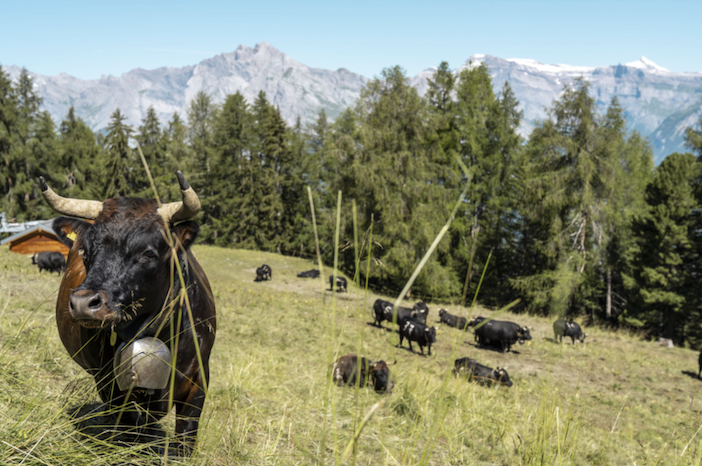
On this mild evening, we catch them heading to a nearby dairy farm to be milked by the cowherds who spend the season tending them. Weighing up to 700 kilos they’re an intimidating presence, and as the herd muscles by in a cacophony of clanging cowbells, butting each other and lowing loudly, I’m surprised to spot Anita stroking a group of stragglers like docile lambs. “They may look scary,” she tells me, “but they’re very gentle”. I’m not convinced.
Of the excellence of their produce, however, I need no persuading. Valais raclette is heralded as Switzerland’s best, with its rich flavour attributed to the region’s alpine plants. The purpose of our walk is to enjoy raclette the original rustic way; outdoors in the mountains. High above the village of Haute-Nendaz at an altitude of nearly 2000 metres, we settle into a pocket on the mountainside where Anita starts a fire with branches and beeswax, against which she melts a half wheel of raclette.
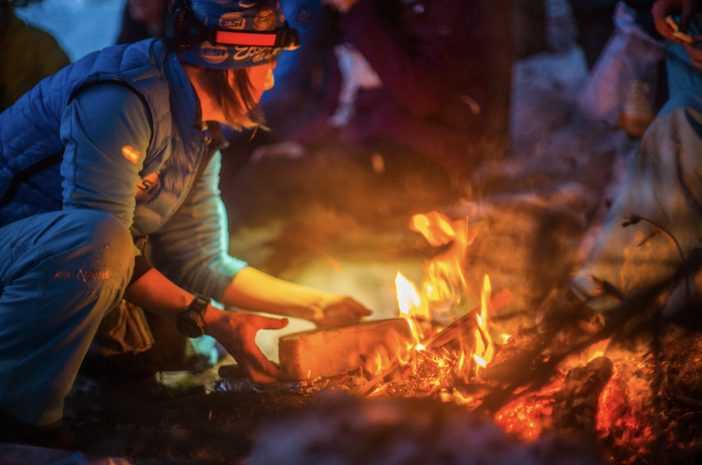
As the cheese bubbles, we watch the evening sun cling to the peaks opposite, turning them a gentle orange that echoes the fire, while shadows creep up their slopes. Flames crackle and cowbells ring across the mountains as Anita hands us round after round of molten raclette scraped onto fresh bread, accompanied by slices of cured beef, pork saucisson and local Fendant wine. There are moments during travels that stand out long afterwards, and as our group talks and laughs into the night, I’m aware this simple dinner in spectacular scenery is one of them.
The alpine canton of Valais – part of the 4 Vallées ski region – lies on the border with France, two hours’ drive from Geneva. It’s home to 4,000 mountains – impressive even by Swiss standards – and from its Rhône Valley there are 360-degree mountain views, including of the Matterhorn, Les Diablerets and the Glacier 3,000 peak. This wide valley ensures the canton basks in sun, enjoying 300 days of it annually, which means that despite the difficult terrain the region is replete with brimming orchards. Over the course of my trip, apricots, apples and plums feature widely in Valais’ autumn offering – whether dried, baked in tarts or transformed into juices, syrups and liquors – yet it’s the grape that’s the most prized fruit.
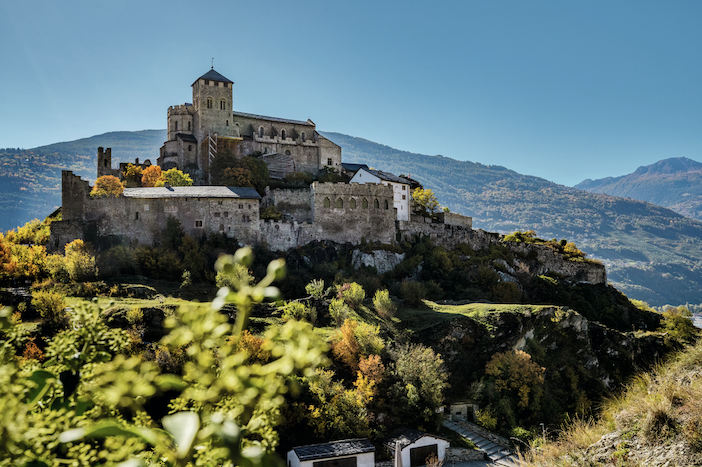
Valais is Switzerland’s largest wine-growing region, and as we drive to the ancient town of Sion on a sunny September morning, vineyards scale the slopes in all directions. I’m told every available winegrowing space has been used – which rings true when we pass a roundabout doubling as a miniature vineyard.
The canton has 18,000 grape growers, but Les Celliers de Sion is one of the most established. Its wine park is anchored by a sparkling building dedicated to wine tourism and surrounded by almost vertical vineyards whose terraces date back to the 15th century. In contrast to the ‘heroic viticulture’ this manual harvesting requires, we spend the morning enjoying an extensive wine tasting that finishes with a lavish lunch of local cheeses, meats and fruits. For oenology enthusiasts, there are also workshops, courses, gourmand hikes and e-biking tours through the vineyards.

It’s this combination of epicurean indulgence and physical activity in an outdoor wonderland that makes Valais so enticing. In winter, there are 2,800km of slopes to ski, while summer offers 9,000km of hiking trails and 2,000km of cycling routes, which next year will host the World Mountain Biking Championships.
Keen to explore this terrain, we hire e-mountain bikes and spend hours scaling deserted slopes that lead us to hidden waterfalls and meadows dotted with wooden chalets. As we pause to admire a secluded glen, our athletic guide Romain reveals that despite being a keen skier autumn is his favourite season, when a few weeks from now the ubiquitous larch trees will turn golden, setting the landscape aglow. As we take in the still-verdant scene, a buzzard circles majestically, while in the forest behind us black squirrels dart around, and a rare marmot pauses briefly infront of its camouflage of rocks. Summer and winter may draw the big crowds, but this vivid autumnal interlude has its own beauty – and a quietude that feels like we have the landscape to ourselves.
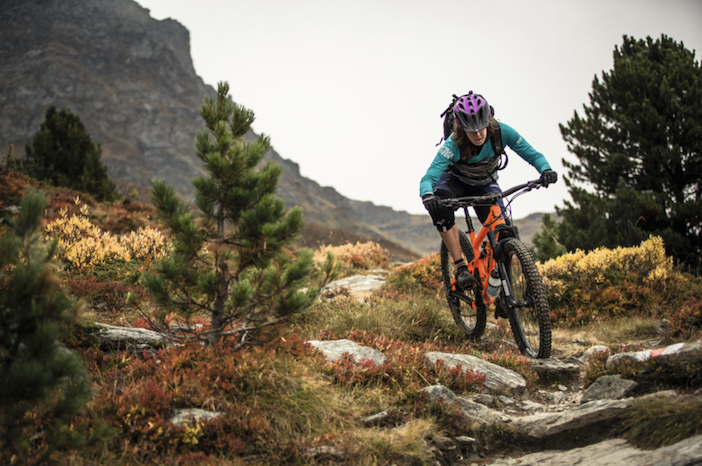
After cycling 30km our appetites direct us to the timeless village of Verrey and its Cab’Anne Café – a cosy Himalayan-inspired hut perched on the mountainside, where we order croûte au fromage – a hearty, open-faced sourdough sandwich baked in an extravaganza of raclette, ham, mushrooms and white wine topped with cornichons and a fried egg. It’s delicious but worthy of a nap. So, after a perfectly flaky plum tart and an unwise shot of génépi (a cousin of absinthe), we make a sleepy return to the village of Haute-Nendaz, each of us resorting to the bikes’ turbo mode on the final hills.
Thankfully the newly-built MAD Mount Hotel where we’re staying has a well-equipped spa, and it’s here that I spend the rest of the afternoon gliding between its spacious hammam and saunas while watching my more intrepid companions do battle with the plunge pool. As I recuperate in the spa’s warm embrace, a rain shower descends on the village, falling gently against the spa’s glass walls and heightening its serenity.
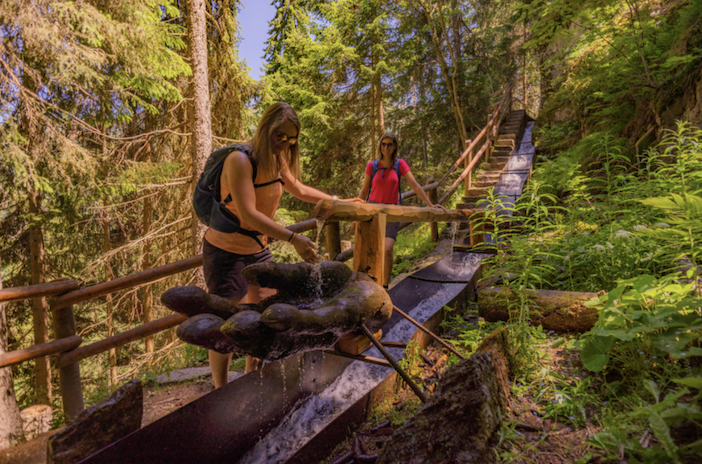
In contrast to the busier Haute-Nendaz, further along the valley is Veysonnaz – a small mountain village resting at the top of some hairpin bends. In winter, skiers swell its population from 600 to 4,000, but in autumn Veysonnaz is a great place from which to explore Valais’ bisses. This 14th century irrigation system weaves across the landscape and is still used to bring water down from the mountains today. Nature trails now accompany these historic watercourses and so after a night at the cosy Hotel Chalet Royal, whose balconied rooms provide panoramic views of the Rhône Valley and Bernese Alps behind, we embark on a four-hour trail from Veysonnaz to Haute-Nendaz.
With sunlight streaming through the forest on our left and open views of the valley on our right, we follow a bisse across woods, waterfalls and meadows, curving around the mountain while water babbles softly beside us. Midway, we reach the pretty hamlet of Planchouet in a glen scattered with wildflowers and crickets, where we relax on Le Restaurant de Planchouet’s terrace. In the distance, a helicopter is transporting chairlift parts across the valley in preparation for winter, when I imagine this restaurant must be packed. But for now, as I eat local Serac cheese and salad while soaking up the sunshine, I can’t picture a better time to visit.
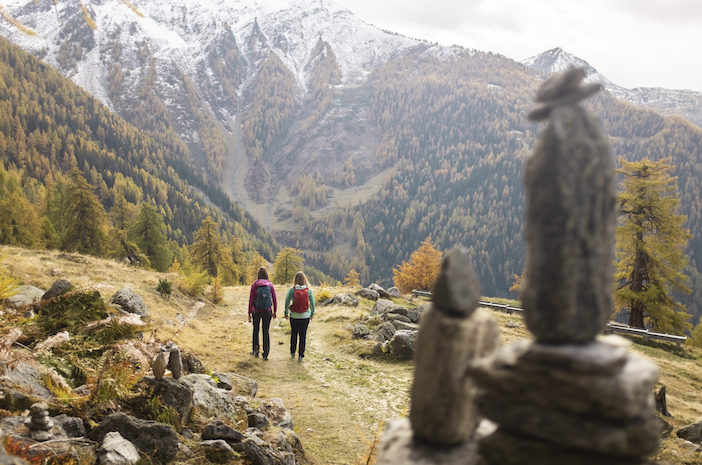
On our final morning in Haute-Nendaz I open my curtains and gasp. The first snow of the season has arrived, dusting the mountaintops in powder and enhancing the autumnal scene. Soon it will be time for the annual désalpe, when the cows are brought down from the mountains with the victorious queen garlanded in flowers. As I take in this spectacular valley one last time it strikes me that, with its colourful landscape, copious sunshine and flavourful cuisine, perhaps autumn does take the crown as Valais’ most enchanting time of year.
For more information on Nendaz-Veysonnaz, visit nendaz.ch and veysonnaz.ch. For e-biking tours visit onyabike.ch, for raclette mountain tours visit zigzago.ch, and for Les Celliers de Sion visit celliers.ch.
SWISS connects Switzerland with more than 160 weekly flights from London Heathrow, London City, Manchester, Birmingham and Edinburgh to Zurich or Geneva. One-way fares start from £76 to Zurich and £54 to Geneva, and include all taxes, fees and surcharges. For more information visit swiss.com.
Travel Switzerland offers international visitors to Switzerland unlimited travel on consecutive days across the rail, bus and boat network, plus scenic routes (seat reservation fees apply) and local trams and buses in around 90 towns and cities. It also includes the Swiss Museum Pass, which grants free entry to 500 museums and exhibitions. Prices start from £229/€268 for a three-day second-class ticket. Visit www.switzerland.com/travel




